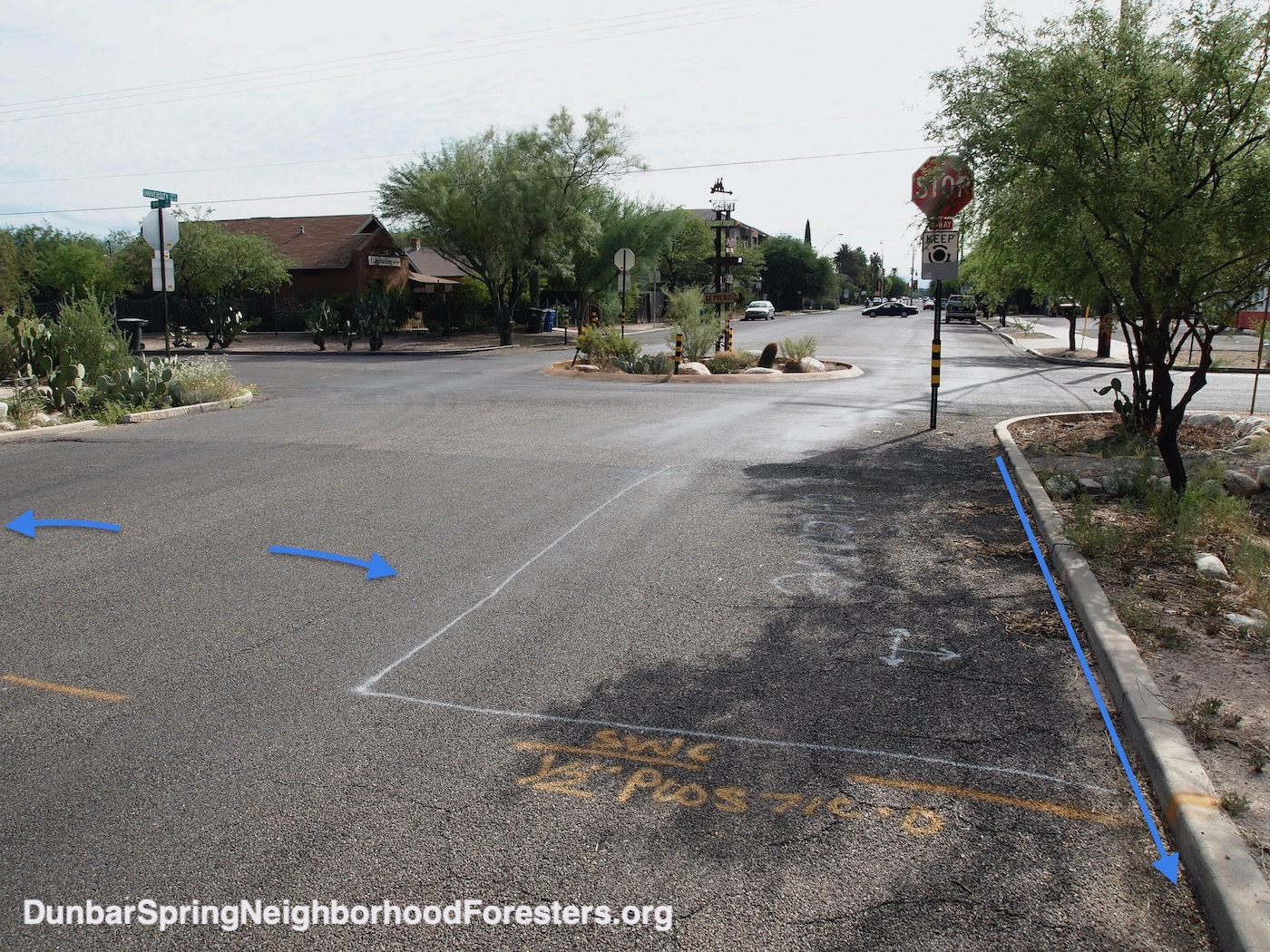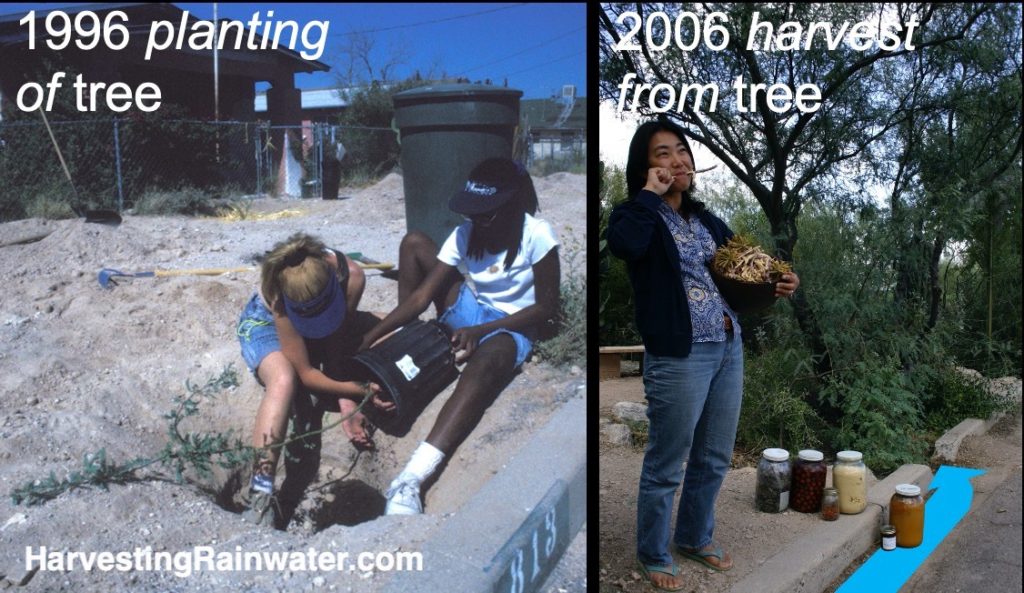Dunbar/Spring Neighborhood Rain-Irrigated Native Food Forest
An example of how any neighborhood can harvest free on-site waters (such as rain, and stormwater/street runoff) to freely irrigate and grow a community-building neighborhood native food forest.

Excessively wide streets and pavement increase neighborhood temperatures and speeding traffic.
Blue arrows denote water flow.
Photo: Brad Lancaster, 2010

Rainwater- and street-runoff-harvesting, traffic-calming, curb extension/chicane and round-a-bout, along with street-side plantings passively irrigated with harvest street runoff in Dunbar/Spring Neighborhood.
Street is narrowed, pavement is reduced, and more shading vegetation grown, which reduces neighborhood temperatures and speeding traffic.
Blue arrows denote water flow.
Photo: Brad Lancaster 8-2021, at end of summer rainy season.
The first annual neighborhood rain and tree planting began in 1996 with the planting of over 200 Tucson Basin-native, 5-gallon-sized food-bearing trees mostly in the public-rights-of-ways of the neighborhood and some in private yards. Native trees were selected as they are the best adapted to our local climate, soils, and wildlife; so, it is easiest to succeed with these trees. It was organized by neighborhood resident and activist Brad Lancaster, and funded by a $1,000 PRO Neighborhoods grant—all of which went to providing the trees for free. The 5-gallon-sized trees were planted within 3-foot diameter water-harvesting basins (adequately sized for the smaller plants at planting time, but not ideally sized for the plants water needs as they grew to maturity—we later evolved the program to address that).

Photos: Brad Lancaster
The program has continually evolved. Now all strata/layers of the native food forest are planted at the same time as the trees. The other layers include large shrubs, small shrubs, still smaller ground cover plants, grasses, cacti, tubers, vines, etc. The understory plants are planted as seed, transplants that emerge in the rainy season, or nursery stock not exceeding 1-gallon in size (which keeps costs down and is easier to plant). Interestingly, we find smaller-sized plants (like a 1- or 5-gallon plant) typically catch up with and surpass larger sized plants (like a 15-gallon plant) within three to five years. Neighbors pay for, or donate, the plants we purchase from local native plant nurseries.
From 1996 to 2022 we as neighbors have planted over 1,600 trees and thousands of understory plants in the neighborhood.
As has always been the case, the rain is planted before the plants, by creating water-harvesting basins, earthworks, or rain gardens. The plants are then planted within or beside these earthworks/basins.
But now much larger basins are created, large enough to harvest all the water the plants within them will need (once established—establishment period is 1 to 3 years) at maturity, with surplus to help recharge our groundwater and further reduce downstream flooding.
The average basin size is now 8-feet long by 5-feet wide by 1-foot deep for an average annual water-harvesting capacity of over 4,500 gallons per basin. The basins are also made deeper than the adjoining street and pedestrian path, so the runoff from both fills the basins.
This way the street waters the street trees and understory plants for free. The vegetation then grows to shade and cool the street, public walkways, and adjoining homes and properties.
Another evolution is that now when we plant, we also ensure the public pathways by the plantings are enhanced for public accessibility. So, paths are widened to 5-feet (so two people can walk side by side, and/or a parent can push a baby carriage with another child or pet walking beside them). Surface materials that make accessibility more difficult (such as gravel which bogs down wheels and the feet of the elderly and the very young) are removed. And adjoining property owners sign an agreement that they will prune the vegetation to maintain a minimum 5-foot width and 7-foot height of continuous clear space for the public paths.
Organic mulch and nutrients are also harvested in these basins in the form of leaf drop, prunings cut-up to 6-inch or shorter pieces, and manure from the birds and insects on the vegetation. This creates a more absorptive sponge that more quickly infiltrates water, and holds onto it longer into the dry times.
Efforts were dramatically enhanced when in 2009 the neighborhood got a $500,000 Pima County Neighborhood Reinvestment Grant, which the neighborhood decided to spend on water harvesting, tree planting, traffic calming, and public art. But instead of doing each of these things separately, we integrated them. So, our traffic calming round-a-bouts also harvest rain and street runoff to freely grow trees and understory plants within them, then sculptures and other art installations tell the bigger story.
We now plant/harvest over 1 million gallons of stormwater per year in our neighborhood’s public right-of-way rain gardens.
This is only the beginning. We need to do at least 30 times more. Thus, our annual rain and native food forest planting program continues.
The average residential street in Tucson drains over 1 million gallons of rainwater runoff per year. If that runoff from the street were directed to street-side basins and plantings sized to absorb all that runoff, the streets would provide enough runoff water to freely irrigate 400 native trees per mile, or one tree every 25 feet on both sides of the street. Thus, every street and its walkways could be shaded by a continuous corridor of low-water-use shade trees, irrigated solely by the runoff from the street!
Another advantage is the street-side basins create a physical barrier that keeps cars out of the pedestrian zone, making for more alluring pedestrian paths, while the in-street water-harvesting and traffic-calming curb-extension/chicane basins protect and shelter cars parked on the street, making on-street parking more alluring, so there is more room to plant water and trees on private property and in the public rights-of-ways. But more is needed.
We can’t stop planting, because there is still a lot of bare space, and trees and other plants are always getting cut down in the urban environment. And we could go further in increasing the diversity of multi-use plantings in the neighborhood (there are over 400 native food plants in the Sonoran desert).
We also have to keep building/evolving our capacity and that of our community. So, we have events, workshops, and work parties throughout the year for planting, harvesting, pruning, mulching, composting, and more. Neighborhood goats now help too, by digesting prunings, and their composted bedding then provides mulch for new water-harvesting basins.
In 2-2025 the Dunbar/Spring Neighborhood Foresters installed four more water-harvesting traffic-calming chicanes or curb extensions around the intersection of 9th Avenue and University Blvd (where two of the neighborhood’s bicycle boulevards intersect) with Inflation Reduction Act grant funds through the Arizona State Forestry Department.
Simultaneously, the Neighborhood Foresters coordinated the installation to two speed humps approaching this intersection to further enhance the safety of the bicycle boulevards.
For more information and photos:
DunbarSpringNeighborhoodForesters.org
Evolutions within the Dunbar/Spring Neighborhood Pubic Commons
Before and After photos of Green Infrastructure in Dunbar Spring Neighborhood
Multi-lingual plant identification signs
Before and after photos and signage
Where:
9th Avenue and University Blvd.
There is a good amount of educational signage within a half-block radius of this intersection, though you can explore the public right-of-way water-harvesting and native food forest installations throughout the neighborhood which extends from Speedway Blvd to the north, the railroad tracks to the south, Stone Avenue to the east, and the railroad tracks to the west.
32.23182470731162, -110.97340827646103
On the east side of the community bulletin board at the SW corner of 9th Ave and University Blvd you’ll also find bilingual maps of our rain-irrigated neighborhood forest and its public trails.
Hours: the public rights-of-ways pedestrian paths are always open
Cost: free
Get involved by signing up to be one of our neighborhood foresters, and start a neighborhood foresters group in your neighborhood
Pets on leash are allowed
This location is included in the following tours:
See the new, full-color, revised editions of Brad’s award-winning books
– available a deep discount, direct from Brad:

Volume 1

